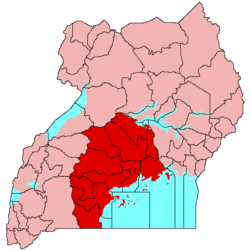Buganda | |
|---|---|
Traditional tribal kingdom | |
| Anthem: Ekitiibwa kya Buganda | |
 Buganda is shaded red on this map | |
| Sovereign state | |
| Capital | Mengo |
| Government | |
| • Type | Constitutional monarchy |
| • Body | Lukiiko |
| • Kabaka | Ronald Muwenda Mutebi II |
| • Katikkiro (Prime Minister) | Charles Peter Mayiga |
| Area | |
| • Total | 61,403.2 km2 (23,707.9 sq mi) |
| Elevation | 1,200 m (3,900 ft) |
| Population (2002 census)[1] | |
| • Total | 6,575,425 |
| • Estimate (2021) | 11,952,600[2] |
| • Density | 110/km2 (280/sq mi) |
| Time zone | UTC+3 (EAT) |
| Website | https://www.buganda.or.ug/ |
| Ganda | |
|---|---|
| Person | muGanda |
| People | Baganda |
| Language | Luganda |

Buganda is a Bantu kingdom within Uganda. The kingdom of the Baganda people, Buganda is the largest of the traditional kingdoms in present-day East Africa, consisting of Uganda's Central Region, including the Ugandan capital Kampala. The 14 million Baganda (singular Muganda; often referred to simply by the root word and adjective, Ganda) make up the largest Ugandan region, representing approximately 16% of Uganda's population.[3][4]
Buganda's history includes unification during the 13th century by the first king Kato Kintu, the founder of Buganda's Kintu Dynasty, Buganda grew to become one of the largest and most powerful states in East Africa during the 18th and 19th centuries.[citation needed] During the Scramble for Africa, and following unsuccessful attempts to retain its independence against British imperialism, Buganda became the center of the Uganda Protectorate in 1884; the name Uganda, the Swahili term for Buganda, was adopted by British officials. Under British rule, many Baganda acquired status as colonial administrators, and Buganda became a major producer of cotton and coffee.
Following Uganda's independence in 1962, the kingdom was abolished by Uganda's first Prime Minister Dr Apollo Milton Obote in 1966, declaring Uganda a republic. Following years of disturbance caused by Obote and dictator Field Marshall Idi Amin Dada, as well as several years of internal divisions among Uganda's ruling National Resistance Movement under Yoweri Kaguta Museveni Tibuhaburwa, the President of Uganda since 1986, the kingdom was officially restored in 1993. Buganda is now a traditional kingdom and so occupies a largely ceremonial role.
Since the restoration of the kingdom in 1993, the King of Buganda, known as the Kabaka, has been Muwenda Mutebi II. He is recognized as the 36th Kabaka of Buganda. The current queen, known as the Nnabagereka or Kaddulubale is Queen Sylvia Nagginda.[5]
- ^ a b "Uganda: Administrative units (source: Uganda Bureau of Statistics)". GeoHive. Retrieved 18 June 2013.
- ^ Cite error: The named reference
ubospop2021was invoked but never defined (see the help page). - ^ "The World Factbook — Central Intelligence Agency". www.cia.gov. Retrieved 14 May 2018.
- ^ "Buganda | Kabaka, Lake Victoria, Uganda | Britannica". www.britannica.com. Retrieved 2024-01-23.
- ^ "Buganda Kingdom". www.buganda.or.ug. Retrieved 2024-01-23.
